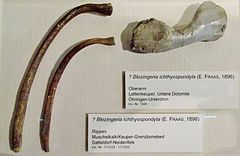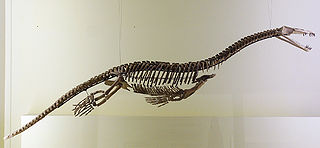
Nothosaurus is an extinct genus of sauropterygian reptile from the Triassic period, approximately 240–210 million years ago, with fossils being distributed from North Africa and Europe to China. It is the best known member of the nothosaur order.

Lariosaurus is an extinct genus of nothosaurid from the Middle Triassic of central and western Europe and China. With a complete specimen of L. xingyiensis measuring 70.5 cm (2.3 ft) long and L. hongguoensis possibly measuring up to 80 cm (2.6 ft) long, it was one of the smallest known nothosaurs. First discovered at Perledo on the Lake Como in 1830, it was named in 1847 by Curioni, its name meaning "Lizard from Larius", the ancient name of the lake. This makes it one of the earliest studied reptiles from the Alps. It is known from an almost complete skeleton holotype and several other fairly complete fossils.
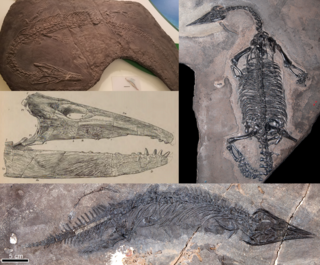
Thalattosauria is an extinct order of marine reptiles that lived in the Middle to Late Triassic. Thalattosaurs were diverse in size and shape, and are divided into two superfamilies: Askeptosauroidea and Thalattosauroidea. Askeptosauroids were endemic to the Tethys Ocean, their fossils have been found in Europe and China, and they were likely semiaquatic fish eaters with straight snouts and decent terrestrial abilities. Thalattosauroids were more specialized for aquatic life and most had unusual downturned snouts and crushing dentition. Thalattosauroids lived along the coasts of both Panthalassa and the Tethys Ocean, and were most diverse in China and western North America. The largest species of thalattosaurs grew to over 4 meters (13 feet) in length, including a long, flattened tail utilized in underwater propulsion. Although thalattosaurs bore a superficial resemblance to lizards, their exact relationships are unresolved. They are widely accepted as diapsids, but experts have variously placed them on the reptile family tree among Lepidosauromorpha, Archosauromorpha, ichthyosaurs, and/or other marine reptiles.

Cyclotosaurus is an extinct genus of temnospondyl within the family Mastodonsauridae. It was of great size for an amphibian, had an elongated skull up to 56 cm (22 in).
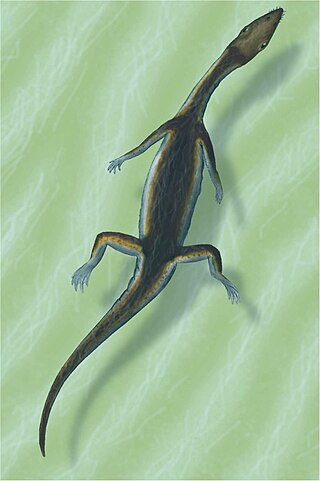
Serpianosaurus is an extinct genus of pachypleurosaurs known from the Middle Triassic deposits of Switzerland and Germany. It was a small reptile, with the type specimen of S. mirigiolensis measuring 75 cm (2.46 ft) long.

Colobodus is an extinct genus of marine Triassic ray-finned fish of the family Colobodontidae and order Perleidiformes. Fossils have been found in Europe and China, encompassing the former Tethys Ocean. It could reach body lengths of about 70 cm.

Helveticosaurus is an extinct genus of diapsid marine reptile known from the Middle Triassic of southern Switzerland. It contains a single species, Helveticosaurus zollingeri, known from the nearly complete holotype T 4352 collected at Cava Tre Fontane of Monte San Giorgio, an area well known for its rich record of marine life during the Middle Triassic.

Simosaurus is an extinct genus of marine reptile within the superorder Sauropterygia from the Middle Triassic of central Europe. Fossils have been found in deposits in France and Germany that are roughly 230 million years old. It is usually classified as a nothosaur, but has also been considered a pachypleurosaur or a more primitive form of sauropterygian.

Sinosaurosphargis is an extinct genus of basal marine saurosphargid reptile known from the Middle Triassic Guanling Formation of Yunnan and Guizhou Provinces, southwestern China. It contains a single species, Sinosaurosphargis yunguiensis.
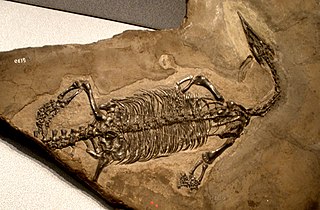
Askeptosauroidea is a superfamily of thalattosaurs, a Triassic group of marine reptiles. Askeptosauroidea is one of two major subgroups of Thalattosauria, the other being Thalattosauroidea. It includes the family Askeptosauridae and a more basal form called Endennasaurus.

Askeptosauridae is a family of thalattosaurs within the superfamily Askeptosauroidea. Fossils have been found from Italy, Switzerland, and China. Askeptosaurids are distinguished from other thalattosaurs by their long necks and narrow skulls.

Anshunsaurus is a genus of thalattosaurs within the family Askeptosauridae. Fossils have been found from Middle Triassic deposits in Guizhou, China. Three species are known: the type species A. huangguoshuensis, the slightly older species A. wushaensis, and the species A. huangnihensis.

Thalattosauroidea is a superfamily of thalattosaurs, a Triassic group of marine reptiles. It was named in 1904 by paleontologist John Campbell Merriam to include the genus Thalattosaurus from California. Thalattosauroids are one of two groups of Thalattosauria, the other being Askeptosauroidea. Thalattosauroids make up the "traditional" thalattosaurs with large downturned snouts, short necks, and long, paddle-like tails.
Psephosauriscus is an extinct genus of placodont reptile from the Middle Triassic of Israel and Egypt. It is known from bony armor plates that have been found from Makhtesh Ramon in Israel's Negev desert and Araif en Naqua on Egypt's Sinai Peninsula. The genus was erected in 2002 as a replacement name for several species of the genus Psephosaurus, which was named in 1957. It includes the species P. mosis, P. ramonensis, P. sinaiticus, and a possible fourth species, P. rhombifer. All species, with the exception of P. ramonensis, were once assigned to the genus Psephosaurus. Remains of P. mosis and P. ramonensis were found in Makhtesh Ramon, while P. sinaiticus and P. rhombifer were found in Araif en Naqua.
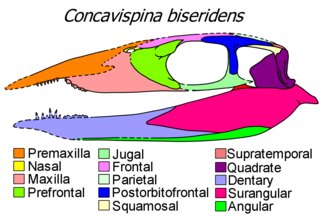
Concavispina is an extinct genus of thalattosaur reptile from the early Late Triassic Xiaowa Formation of Guangling, Guizhou, southern China. It contains a single species, Concavispina biseridens. It is known only from the holotype ZMNH M8804, a nearly complete 364 cm long skeleton. Concavispina can be differentiated from other thalattosaurs by possessing two rows of blunt teeth on the anterior part of the maxilla and a V-shaped notch on the dorsal margin of each neural spine in the dorsal (back) vertebrae. Both its generic and specific names refer to these autapomorphies, as Concavispina means "concave spine" and biseridens means "two rows of teeth". It is thought to be most closely related to Xinpusaurus, as both taxa share three derived characters: a maxilla that is curved upward at its anterior end, a humerus that is wider near the shoulder than near the elbow, and the presence of less than five cervicals.

The Erfurt Formation, also known as the Lower Keuper, is a stratigraphic formation of the Keuper group and the Germanic Trias supergroup. It was deposited during the Ladinian stage of the Triassic period. It lies above the Upper Muschelkalk and below the Middle Keuper.

Tholodus is an extinct genus of basal ichthyopterygian known from the Middle Triassic of Germany, northeastern Italy and possibly China. It was first named by Christian Erich Hermann von Meyer in 1851 and the type species is Tholodus schmidi. It is known from many disarticulated and fragmentary remains, mainly teeth and jaw fragments. Most specimens were collected from various localities across the Ladinian-aged Muschelkalk, Germany, mainly from the Jena Formation of the upper Lower Muschelkalk, where the holotype was found. Dalla Vecchia (2004) recently described two additional specimens, a mandibular ramus and a maxilla, both bearing teeth and nearly uncrushed, and some postcranial remains, from a single late Anisian outcrop, from the southern Alps of Italy. The humerus resembled that of immature individuals of the Asian genus Chaohusaurus, suggesting possible affinities to Grippidia.

Saurosphargidae is an extinct family of marine reptiles known from the Early Triassic and early Middle Triassic of Europe and China.
The Besano Formation is a geological formation in the southern Alps of northwestern Italy and southern Switzerland. This formation, a thin but fossiliferous succession of dolomite and black shale, is famous for its preservation of Middle Triassic (Anisian–Ladinian) marine life including fish and aquatic reptiles. It is exposed in the Monte San Giorgio and Besano area. It is among the formations responsible for the area being designated as a UNESCO World Heritage Site. In Switzerland, it is also known as the Grenzbitumenzone. The Anisian-Ladinian boundary lies in the upper part of the Besano Formation.
The Zhuganpo Formation is a Triassic geologic unit found in southern China. It has historically been known as the Zhuganpo Member of the Falang Formation. A diverse fossil assemblage known as the Xingyi biota or Xingyi Fauna can be found in the upper part of the Zhuganpo Formation. Fossils of the Xingyi biota include articulated skeletons of marine reptiles, abundant fish, and a plentiful assortment of invertebrates indicating a Ladinian to Carnian age for the sediments of the formation.
